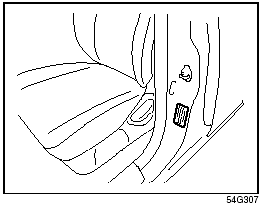 Suzuki Grand Vitara: Vehicle Loading
Suzuki Grand Vitara: Vehicle Loading

Vehicle Loading
Your vehicle was designed for specific weight capacities. The weight capacities of your vehicle are indicated by the Gross Vehicle Weight Rating (GVWR), the Gross Axle Weight Rating (GAWR, front and rear) and the Vehicle Capacity Weight. The GVWR and GAWR (front and rear) are listed on the Safety Certification Label which is located below the driver’s side door latch striker. The Vehicle Capacity Weight is listed on the Tire Information Label which is located below the Safety Certification Label. GVWR – Maximum permissible overall weight of the fully loaded vehicle (including all the occupants, accessories and cargo plus the trailer tongue weight if towing a trailer).
GAWR – (Front and Rear) Maximum permissible weight on an individual axle. Vehicle Capacity Weight – Maximum permissible load weight a vehicle can carry including the weight of all the occupants, accessories, cargo, plus trailer tongue weight (if towing a trailer). The weight of any accessories already installed on your vehicle at the time of purchase, or that you or the dealer install after purchase, must be subtracted from the Vehicle Capacity Weight to determine how much capacity remains available for occupants, cargo, and trailer tongue weight (if towing a trailer). Contact your dealer for further information. Actual weight of the loaded vehicle and actual loads at the front and rear axles can only be determined by weighing the vehicle using a vehicle scale. To measure the weight and load, try taking your vehicle to a highway weighing station, shipping company or inspection station for trucks, etc. Compare these weights to the GVWR and GAWR (front and rear) listed on the Safety Certification Label. If the gross vehicle weight or the load on either axle exceeds these ratings, you must remove enough weight to bring the load down to the rated capacity.
 WARNING: Never overload your
vehicle. The gross vehicle weight (sum of the weights of the loaded vehicle, driver
and passengers) must never exceed the Gross Vehicle Weight Rating (GVWR) listed
on the Safety Certification Label. In addition, never distribute a load so that
the weight on either the front or rear axle exceeds the Gross Axle Weight Rating
(GAWR) listed on the Safety Certification Label.
WARNING: Never overload your
vehicle. The gross vehicle weight (sum of the weights of the loaded vehicle, driver
and passengers) must never exceed the Gross Vehicle Weight Rating (GVWR) listed
on the Safety Certification Label. In addition, never distribute a load so that
the weight on either the front or rear axle exceeds the Gross Axle Weight Rating
(GAWR) listed on the Safety Certification Label.
 WARNING:
WARNING:
• Always distribute cargo evenly.
• To avoid personal injury or damage to your vehicle, always secure cargo to prevent
it from shifting if the vehicle moves suddenly.
• Place heavier objects on the floor and as far forward in the cargo area as possible.
Never pile cargo higher than the top of the seat backs.
 Trailer Towing
Trailer Towing
You can use your SUZUKI to tow a trailer, but you should always observe the requirements
and recommendations in this section. If you intend to tow a trailer, it is essential
to select a trailer an ...
See also:
Replacing Tires andWheels
Replace your tires with radial tires of
the same size, load range, speed
rating, and maximum cold tire
pressure rating (as shown on the
tire’s sidewall).
Mixing radial and bias-ply tires on ...
Tailgate
The tailgate will lock when you lock
the driver’s door with the key, the
remote transmitter, the master door
lock switch, or the lock tab on the
driver’s door.
To unlock the tailgate, tur ...
To install the second row cushion
1. Push the cushion to the inboard
side of the vehicle.
2. Make sure that the hinges are
locked into place.
...

